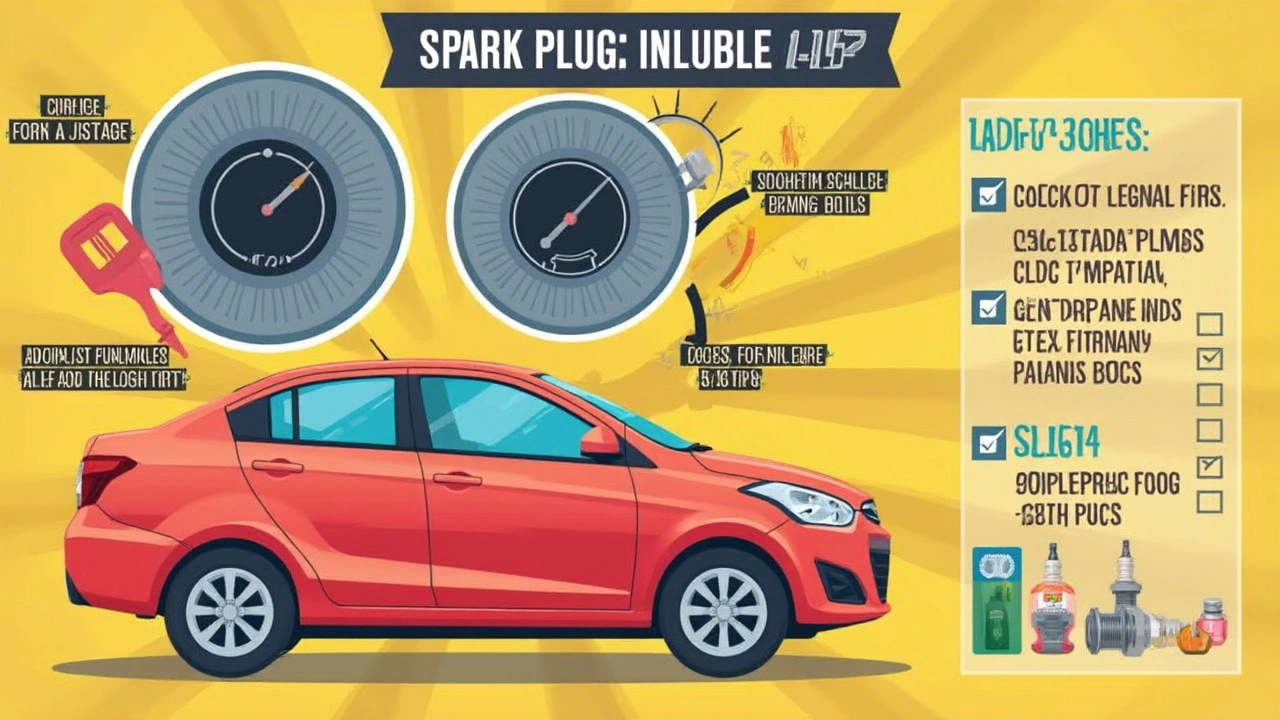Ever notice your car running rough, burning more gas than usual, or struggling to start? Bad spark plugs are often to blame, and these tiny parts quit faster than most people expect. They’re supposed to light the fuel in your engine—and if they don’t work right, everything else goes downhill fast.
People think spark plugs are “install and forget” parts, but that’s not true. How you drive, what kind of fuel you use, and even the weather can trash new plugs way before their time. Lots of folks are surprised to find out that short trips and city driving burn through spark plugs much quicker than cruising down the highway.
Neglecting maintenance is one of the fastest ways to kill your spark plugs. Skipping oil changes, ignoring a check engine light, or letting an air filter get clogged pushes dirt and carbon onto your spark plugs, and they just can’t handle it. And here’s a fact: running an engine that burns oil or runs too hot will almost always fry your plugs way early—sometimes in months instead of years.
- What Spark Plugs Actually Do
- Top Reasons Spark Plugs Wear Out Fast
- Warning Signs Your Spark Plugs Are Failing
- How to Make Spark Plugs Last Longer
- When and How to Replace Bad Spark Plugs
What Spark Plugs Actually Do
Spark plugs are simple, but your engine can’t run without them. Their main job is to ignite the air and fuel mix inside your engine’s cylinders. Each time your car’s piston comes up, a spark plug fires an electric spark. That spark lights the fuel, creating a small explosion that pushes the piston back down. Without this quick spark, your engine just won’t start or run right.
One typical car engine has one spark plug for each cylinder. So, if you drive a four-cylinder, you’ve got four spark plugs working together thousands of times every minute. In a V6 or V8, double that. Here’s what the spark plug really handles every second your car is running:
- Withstands temperatures as high as 1,500°C (that’s close to 2,700°F) at the tip.
- Endures massive pressure—sometimes up to 700 psi in high-compression engines.
- Fires an electrical arc up to 50 times per second at high RPMs.
Most modern spark plugs can last anywhere from 30,000 to 100,000 miles, but that number depends on the plug type, engine condition, and how you drive. Here’s a quick table that shows the basic differences between types of spark plugs:
| Type | Material | Typical Lifespan |
|---|---|---|
| Copper | Copper core | 30,000 miles |
| Platinum | Single/Double platinum tip | 60,000 miles |
| Iridium | Iridium tip | Up to 100,000 miles |
Some folks think spark plugs just help the engine start, but they do a lot more. They set the stage for proper combustion, which means smoother running, better fuel economy, and fewer emissions. When a spark plug wears out or gets dirty, it can’t make a strong spark. That’s when you’ll notice things like rough idling or bad fuel mileage creeping up on you.
Top Reasons Spark Plugs Wear Out Fast
There’s more than one way to send spark plugs to an early grave. Most people blame age, but it’s usually a mix of habits and mechanical issues. Once you know what does the most damage, you can do something about it.
- Short Trips and Stop-and-Go Driving: Engines run rich—more fuel, less air—when you’re starting up and in city traffic. This gums up spark plugs fast and leads to carbon deposits. Folks who drive less than 10 miles at a time see failures twice as often as highway drivers.
- Cheap or Wrong Fuel: Using low-quality gasoline or the wrong octane means more sludge and less efficient burning. This forms deposits, which coats and kills spark plugs quickly. In a 2022 garage survey, cars on premium gas saw plug life stretch close to 25% longer.
- Engine Oil Leaks: A leaky valve cover gasket or worn piston rings lets oil seep into the combustion chamber. Oil fouls spark plugs and leaves them sticky and useless in no time.
- Overheating and Pre-ignition: If your engine always runs hot—maybe from cooling issues or timing problems—plugs can literally melt or form blisters. That destroys the tip and kills the spark.
- Improper Gaps or Installation: If a plug isn’t tightened right or is gapped wrong, it won’t spark consistently. Misfires, hesitation, and plug damage follow fast.
- Poor Maintenance: Dirty air filters, weak ignition coils, or old plug wires force the spark plugs to work overtime. They end up wearing down much sooner than any shop manual says they should.
To give you a quick visual, here’s what usually happens to spark plugs when these problems pop up:
| Problem | How It Damages Plugs |
|---|---|
| Rich Fuel Mixture | Black carbon buildup, weak spark |
| Oil Contamination | Wet/oily fouling, total misfire |
| Hot Engine | White blisters, eroded tips |
| Bad Installation | Cracked insulator, lost spark |
Bottom line: Spark plugs pay the price for all kinds of engine trouble and bad habits. Spot the issue, fix it early, and your spark plugs will go the distance.

Warning Signs Your Spark Plugs Are Failing
Catching bad spark plugs early saves you time, money, and frustration. The symptoms aren’t always obvious, so you’ve got to know what to look out for. Here’s how your car will try to tip you off:
- Rough idling: If your engine shakes or sounds like it’s missing when you’re stopped at a red light, your spark plugs could be on their way out.
- Hard starts: Taking multiple cranks to get the engine running? Bad spark plugs often make cold starts a pain, especially when the weather’s cool and damp.
- Poor acceleration: Step on the gas and your car hesitates or feels like it’s bogged down. Healthy spark plugs should fire right away and give you smooth power.
- Worse gas mileage: When spark plugs don’t spark right, your car burns more fuel to make up the difference. If you’re filling up more often but driving the same routes, that’s a big red flag.
- Check engine light: Modern cars often throw a code for misfires or poor combustion. If your check engine light’s on and nothing else seems wrong, pull the spark plugs and take a look.
You might notice these problems one at a time, or several at once. The longer you ignore them, the harder your engine has to work. Here’s something you might not know: statistics from the Car Care Council say that “misfiring spark plugs can decrease fuel efficiency by up to 30%.” That adds up to a lot of wasted money over just a few months.
| Warning Sign | Possible Issue |
|---|---|
| Engine shakes at idle | Bad spark plug or misfire |
| Car struggles to start | Worn spark plug or weak ignition |
| More fuel stops | Poor combustion from faulty plug |
If you spot any of these signs, don’t ignore them. Fixing spark plugs is cheaper than dealing with engine repairs down the line.
How to Make Spark Plugs Last Longer
If you want your spark plugs to go the distance, you need to be proactive—not just lucky. The way you care for your engine and drive on a daily basis makes a huge difference. Here’s how to keep your plugs from dying before their time.
- Check and Change Your Air Filter: A dirty air filter clogs up the engine and makes spark plugs work harder, causing them to foul faster. A fresh filter every 12,000 to 15,000 miles can make a big difference.
- Use Quality Fuel: Cheap gas isn’t just bad for your wallet long-term—it leaves behind debris that can coat your spark plugs. Sticking to a name-brand station helps avoid these issues.
- Go Easy on Short Trips: When you only drive a mile or two, your engine doesn’t get hot enough to burn off deposits. Combine errands when you can, because warm engines are friendlier to your spark plugs.
- Mind Your Oil Changes: Old or low-quality oil means your engine can burn oil or get too hot, which kills plugs fast. Stick to the recommended oil change schedule in your owner’s manual.
- Fix Leaks ASAP: Oil or coolant leaks are a death sentence for spark plugs. If you spot leaks, get them fixed before they reach the plugs.
- Don’t Ignore Engine Lights: A check engine light could mean anything, but a misfire or running rich will roast your spark plugs. Get codes checked right away.
- Gap Your Plugs Right: Even brand-new plugs don’t always come gapped correctly. Double-check the gap before installing to the specs on your hood sticker or manual. Wrong gaps mean faster wear and tear.
For context, here’s a quick look at how different habits can impact spark plug lifespan:
| Driving Habit | Average Plug Lifespan |
|---|---|
| Mostly Highway | 60,000+ miles |
| Mostly City/Short Trips | 20,000-40,000 miles |
| Poor Maintenance | 10,000-20,000 miles |
Keeping your spark plugs alive isn’t rocket science, but it does mean paying attention to the little stuff. These steps won’t just keep your plugs going; they'll help your car run smoother and save you money at the pump.

When and How to Replace Bad Spark Plugs
The best time to swap out your spark plugs is when you notice stuff like a rough idle, slow starts, lousy fuel mileage, or the engine feeling sluggish. Most modern cars can go 60,000 to 100,000 miles on one set (at least that’s what the sticker says), but real life is different if you drive in stop-and-go traffic, short trips, or if you’re using cheaper fuel. Plenty of drivers see issues before that magic 60,000 mark. If you're ever in doubt, just check the owner's manual. Sometimes car makers want you to swap plugs earlier than you’d guess.
Here’s a quick cheat-sheet on when to check or change your spark plugs:
- Your car hesitates, sputters, or shakes at idle
- Hard starts, especially after sitting overnight
- Noticeable drop in gas mileage
- Check engine light comes on for misfire codes
- It’s been more than 5 years or 60,000 miles since your last change
Actually changing spark plugs isn’t rocket science, but you do need the right tools and to follow some basic steps. Anyone with a little patience can save money by doing it themselves.
- Wait until the engine is completely cool. Hot engines can burn you fast.
- Pop the hood and find the spark plugs. They’re usually under the engine cover and look like a row of wires or coils.
- Remove one plug at a time, starting with the wire or coil on top. Pull gently, don’t yank.
- Use a spark plug socket and ratchet to unscrew the old plug. Be careful not to drop anything into the cylinder.
- Check the old plug for oil, carbon, or worn tips—this tells you a lot about your engine’s health.
- Set the new plug to the right gap (use a gap tool—specs should be printed in your manual or on the hood sticker).
- Screw in the new plug by hand first. Then tighten just snug with a wrench—don’t overtighten or you’ll risk snapping it.
- Reconnect the coil or plug wire. Double check it’s snug.
- Repeat for every plug, one at a time so you don’t mix up wires or coils.
If you’re a stat geek, here’s a quick look at average spark plug lifespans by type:
| Type | Expected Lifespan (miles) |
|---|---|
| Copper | 20,000 – 30,000 |
| Platinum | 60,000 – 100,000 |
| Iridium | 80,000 – 120,000 |
After replacing your spark plugs, fire up the engine. If it runs smooth with no shaking or warning lights, you nailed it. Keeping fresh plugs isn’t just good for power—it saves money on fuel and can keep your engine running strong for way longer.




